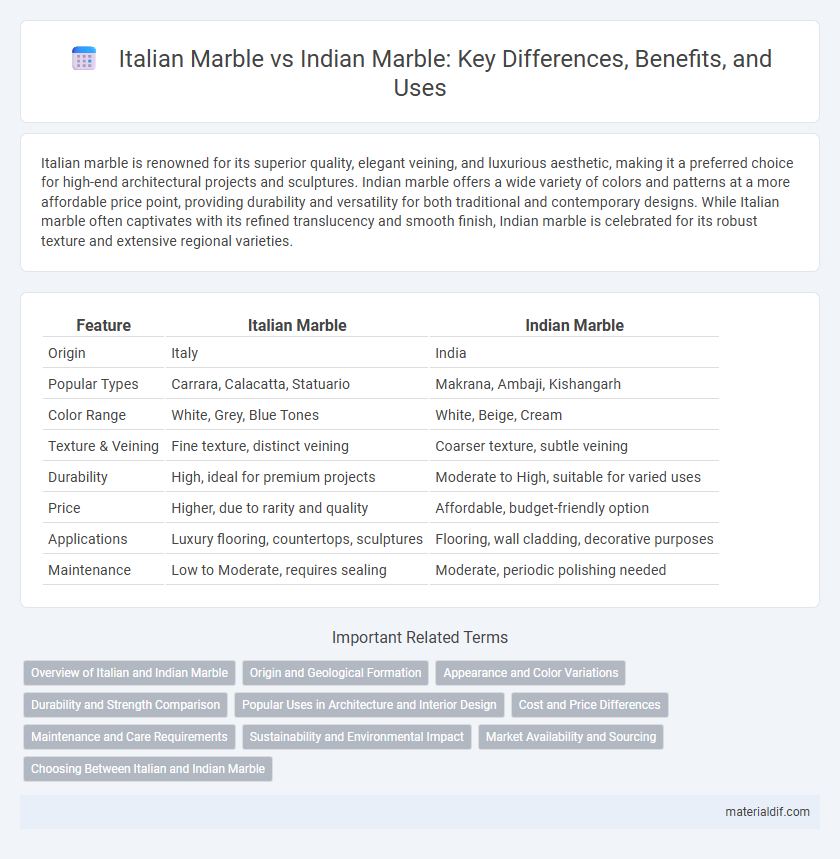Italian marble is renowned for its superior quality, elegant veining, and luxurious aesthetic, making it a preferred choice for high-end architectural projects and sculptures. Indian marble offers a wide variety of colors and patterns at a more affordable price point, providing durability and versatility for both traditional and contemporary designs. While Italian marble often captivates with its refined translucency and smooth finish, Indian marble is celebrated for its robust texture and extensive regional varieties.
Table of Comparison
| Feature | Italian Marble | Indian Marble |
|---|---|---|
| Origin | Italy | India |
| Popular Types | Carrara, Calacatta, Statuario | Makrana, Ambaji, Kishangarh |
| Color Range | White, Grey, Blue Tones | White, Beige, Cream |
| Texture & Veining | Fine texture, distinct veining | Coarser texture, subtle veining |
| Durability | High, ideal for premium projects | Moderate to High, suitable for varied uses |
| Price | Higher, due to rarity and quality | Affordable, budget-friendly option |
| Applications | Luxury flooring, countertops, sculptures | Flooring, wall cladding, decorative purposes |
| Maintenance | Low to Moderate, requires sealing | Moderate, periodic polishing needed |
Overview of Italian and Indian Marble
Italian marble, renowned for its high-quality craftsmanship, features iconic varieties like Carrara and Calacatta, characterized by pristine white backgrounds with elegant grey veining. Indian marble offers diverse options such as Makrana and Ambaji, noted for their durability and distinct color variations ranging from pure white to shades of beige and pink. Both Italian and Indian marbles are preferred in luxury architecture and design for their unique aesthetic qualities and varied applications.
Origin and Geological Formation
Italian marble originates primarily from the Apuan Alps in Tuscany, formed through intense metamorphic processes that compress limestone into dense, crystalline structures known for their fine grain and vibrant veining. Indian marble, predominantly found in Rajasthan's Makrana and Kishangarh regions, is formed from sedimentary limestone that has undergone regional metamorphism, resulting in a softer, more porous stone with a unique range of colors and patterns. The geological differences between Italy's high-pressure metamorphic marble and India's sedimentary-derived marble contribute to their distinct textures, durability, and aesthetic qualities.
Appearance and Color Variations
Italian marble is renowned for its elegant, consistent veining patterns and a wide spectrum of white, cream, and gray hues, often featuring dramatic contrasts that elevate luxury interiors. Indian marble showcases a broader palette ranging from pure whites like Makrana to richer shades of green, pink, and black, with more varied grain and texture. The distinct geological formations in Italy and India contribute to the unique color variations and aesthetic appeal that define each region's marble.
Durability and Strength Comparison
Italian marble, renowned for its high density and low porosity, offers exceptional durability and strength, making it ideal for high-traffic areas and long-lasting installations. Indian marble, while aesthetically versatile and available in various colors, generally exhibits lower density and higher porosity, which can affect its resistance to wear and moisture over time. The crystalline structure of Italian marble contributes to its superior hardness, whereas Indian marble requires more frequent sealing to maintain its integrity in demanding environments.
Popular Uses in Architecture and Interior Design
Italian marble, renowned for its luxurious appearance and high durability, is extensively used in elite architectural projects, including grand staircases, intricate sculptures, and upscale flooring in luxury residences and commercial spaces. Indian marble, prized for its affordability and variety in colors and patterns, is commonly employed in interior design elements like countertops, wall cladding, and traditional flooring in both residential and religious buildings throughout South Asia. Both types of marble are favored for their unique aesthetic appeal and functional versatility, catering to different market segments in global architecture and interior design.
Cost and Price Differences
Italian marble is generally more expensive than Indian marble due to its premium quality, rarity, and global demand, often costing two to three times higher per square foot. Indian marble, such as Makrana or Rajasthan varieties, offers more competitive pricing, making it a popular choice for budget-conscious projects without compromising on aesthetic appeal. The cost disparity is influenced by factors including extraction ease, transportation, and traditional craftsmanship associated with Italian marble.
Maintenance and Care Requirements
Italian marble typically requires more delicate maintenance due to its softer composition and higher porosity, making it more susceptible to staining and etching. Indian marble, known for its durability and lower porosity, generally demands less frequent sealing and is easier to clean, making it more suitable for high-traffic areas. Proper care for both types includes regular sealing, gentle cleaning agents, and prompt spill management to preserve their beauty and longevity.
Sustainability and Environmental Impact
Italian marble is renowned for its high-quality extraction processes that emphasize reduced environmental footprints through advanced quarrying techniques and strict regulations on waste management. Indian marble, while abundant and diverse, often involves traditional mining methods that can lead to higher energy consumption and increased environmental degradation without stringent oversight. Sustainable practices in Italian marble production contribute significantly to minimizing ecological damage, whereas Indian marble industries are increasingly adopting eco-friendly technologies to enhance their environmental performance.
Market Availability and Sourcing
Italian marble, renowned for its high quality and exquisite veining, dominates luxury markets with well-established supply chains primarily sourced from Carrara quarries. Indian marble offers cost-effective alternatives with abundant availability, especially varieties like Makrana and Rajasthan marble, supporting large-scale construction projects. Market availability of Italian marble is more limited and premium-priced, while Indian marble benefits from extensive domestic quarrying and exports at competitive rates.
Choosing Between Italian and Indian Marble
Choosing between Italian and Indian marble depends on factors like aesthetic appeal, durability, and cost-effectiveness. Italian marble, renowned for its luxurious veining and polished finish, often suits high-end architectural projects, while Indian marble offers a diverse range of colors and patterns with greater affordability and resilience. Evaluating project requirements, budget constraints, and desired visual impact ensures selecting the optimal marble type for construction or interior design.
Italian Marble vs Indian Marble Infographic

 materialdif.com
materialdif.com